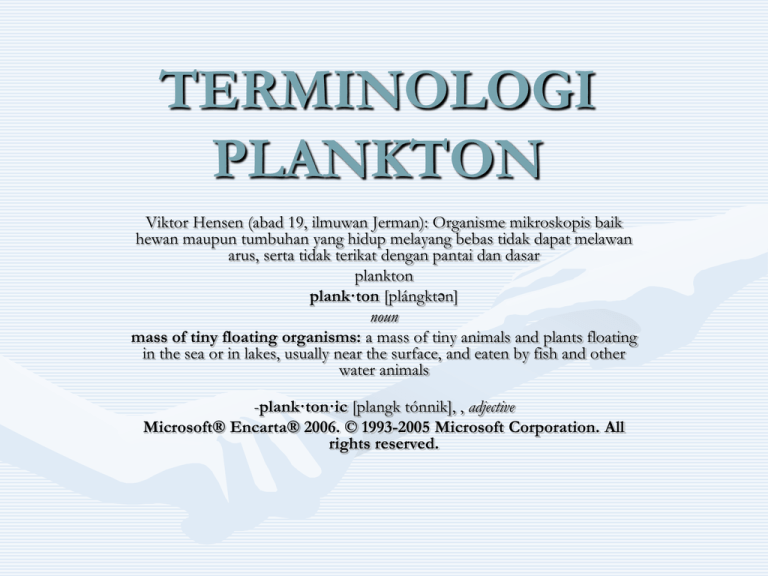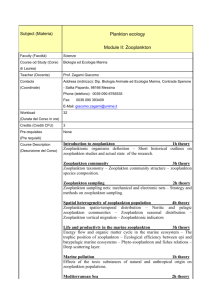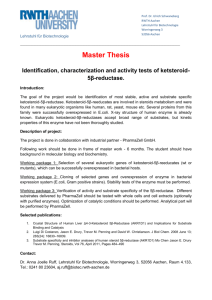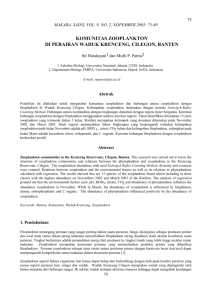
TERMINOLOGI
PLANKTON
Viktor Hensen (abad 19, ilmuwan Jerman): Organisme mikroskopis baik
hewan maupun tumbuhan yang hidup melayang bebas tidak dapat melawan
arus, serta tidak terikat dengan pantai dan dasar
plankton
plank·ton [plángktən]
noun
mass of tiny floating organisms: a mass of tiny animals and plants floating
in the sea or in lakes, usually near the surface, and eaten by fish and other
water animals
-plank·ton·ic [plangk tónnik], , adjective
Microsoft® Encarta® 2006. © 1993-2005 Microsoft Corporation. All
rights reserved.
BEBERAPA FOTO
PLANKTON
• FITOPLANKTON
ZOOPLANKTON
Rotifera
Cladocera
Calanoida
Jellyfish
Cyclopoida
Harpacticoida
Asplanchna
Kenapa dipelajari
• Sumber makanan bagi ikan dan organisme
air lainnya, bahkan manusia
• Penyedia oksigen terpenting di perairan
• Sebagai indikator tingkat kesuburan
• Sebagai indikator tingkat pencemaran
• Sebagai pengawet
Linkages of algae, macrophytes, and fisheries in
lakes
Pengelompokan
Berdasarkan kemampuan membuat makanan:
Fitoplankton (Seluruhnya termasuk algae)
Zooplankton
Phytoplankton Diversity
• More than 4000
species
• Size ranges from
<0.002 to >1mm
• Sexual – asexual
reproduction
• Motile – non-motile
forms
Phytoplankton
Diversity
• morphology
• pigments
• Physiology (storage
products)
• Cell covering
• Polygenetic (widely
seperated in
evolutionary
development)
• Pro- and eucaryotic
taxa
Zooplankton
• Extremely Diverse
• 2 Kingdoms
• 1) Protozoans
– Smaller microzooplankton
• Nano and Pico zooplanters
• 2) Metazoans
– Larger Net zooplankton
Who are the
zooplankters?
Berdasarkan lama hidup sbg plankton
Holoplankton (seluruh siklus hidup sbg
plankton) Examples of holoplankton include
diatoms, radiolarians, dinoflagellates,
foraminifera, amphipods, krill, copepods, and
Meroplankton (satu/bbrapa stadia sbg plankton)
Major heterotrophic Protists
Ciliates (many subdivisions)
-Tintinnid lorica is protein, some with particles stuck on
Sarcodina (“Amoebas” - Naked & shelled amoeba are FW)
-Forminifera (calcite= calcium carbonate)
-Radiolaria (silica)
-Acantharia (strombidium sulfate)
-Heliozoan (silica – rare in marine waters)
Dinoflagellates (autotrophic, mixotrophic or strict heterotrophic
species)
-Thecate (cellulose) & athecate (naked)
Heterotrophic nanoflagellates (HNF)
-Mixture of groups that are difficult to distinguish
taxonomically because they generally lack “shells”
Meroplankton: Planktonic Organisms that
spend only part of their life cycle in the
plankton
Sea urchin
Starfish
Bryozoan Phoronida Annelida (polychaete)
Arthropoda (decopod)
Starfish
Sea Cucumber
Mollusca (gastropod)
Crustacea (barnacle) Nemertea
Berdasarkan ukuran
Nannoplankton/ultraplankton/ mikroplankton (<10µ,
<30µ, <50µ)
Netplankton/mesoplankton (<1mm>60µ)
Makroplankton/megaplankton/ megaloplankton (>
1mm)
Plankton are also often described in terms of size.
Usually the following divisions are used:
However, some of these terms may be used with very
different boundaries, especially on the larger end of the
scale. The existence and importance of nano- and
even smaller plankton was only discovered during
the 1980s, but they are thought to make up the largest
proportion of all plankton in number and diversity.
Group
Size range (ESD)
Megaplankton
2×10-1 and above
Major organisms
(20+ cm)
Macroplankton 2×10-2 →2×10-1 m (2-20 cm)
Mesoplankton 2×10-4→2×10-2 m
(0.2 mm-2
cm)
Microplankton 2×10-5→2×10-4 m (20-200 µm)
metazoans; e.g. jellyfish
metazoans; e.g. pteropods;
chaetognaths
metazoans; e.g. copepods
large eukaryotic protists;
juvenile/small metazoans
Nanoplankton
2×10-6→2×10-5 m (2-20 µm)
small eukaryotic protists
Picoplankton
2×10-7→2×10-6 m (0.2-2 µm)
small eukaryotic protists;
bacteria
Femtoplankton < 2×10-7 m
(< 0.2 µm)
marine viruses
Berdasarkan habitat
Limnoplankton (di danau)
Heleoplankton (di kolam)
Potamoplankton (di sungai)
Hipalmiroplankton (di air payau)
Haliplankton (di laut)
Menurut Nybakken (1988) ada beberapa mekanisme
mengapung yang dilakukan plankton untuk dapat
mempertahankan diri tetap melayang dalam kolom air
yaitu antara lain:
• Mengubah komposisi cairan-cairan tubuh sehingga
densitasnya menjadi lebih kecil dibandingkan densitas air
laut. Mekanisme ini biasa dilakukan oleh Noctiluca dengan
memasukkan amonium klorida (NH4Cl) kedalam
cairan tubuhnya.
Membentuk pelampung berisi gas, sehingga
densitasnya menjadi lebih kecil dari densitas air.
Contoh untuk jenis ini adalah ubur ubur
Menghasilkan cairan yang densitasnya lebih rendah
dari air laut. Cairan tersebut biasanya berupa minyak
dan lemak. Mekanisme ini banyak dilakukan oleh
diatom maupun zoolankton dari jenis copepoda
Memperbesar hambatan permukaan. Mekanisme ini
dilakukan dengan mengubah bentuk tubuh atau
membentu semacam tonjolan/duri pada permukaan
tubuhnya.
Plankton Flotation
Tend to be denser than salt water: Sink
SR = (W1-W2)/(R*Vw)
w1 is the density of an organism, w2 is the
density of seawater, R is the surface
resistance and Vw is the viscosity of water
(related to temperature and salinity)
Reduce Density of Organism:
Decrease W1
Exclude Heavy Ions –
Form body fluids less dense than seawater
Floats
Increase Surface area
R=Surface of resistance
Small size: reduce SA/Volume
Flat
Body Shape or spines
Plankton and Water Movements
Langmuir convection cells
Plankton Reproduction
• Aseksual
Pembelahan Sel
• Seksual
Sperm and Eggs
Alat tangkap/pengumpul
•
•
•
•
Gayung
Ember
Water sampler
Plankton net




